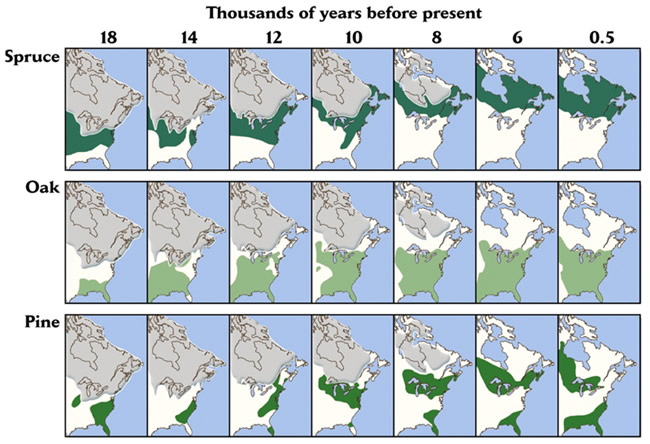in New England
Department of Biological Sciences and Climate Change Institute
Research in paleoecology and paleoclimatolgy has produced strong independent evidence about the post-glacial vegetation and climate of northern New England and adjacent Canada. At the end of the last ice age, between 14,000 and 10,000 years ago, post-glacial environments in the region included extensive areas of treeless tundra. Tree taxa spread into the region gradually from the south, with most current forest elements present by about 8000 years ago.

Subsequent changes in climate greatly affected their distribution and abundance. Between about 9000 and 5000 years ago, temperatures were as much as 2°C warmer and it was considerably drier than today. During this warm period, solar radiation (insolation) in summer was as much as 8% greater than today. White pine (Pinus strobus) was widespread and abundant probably because frequent fires created conditions favorable for seedling establishment. Both white pine and hemlock (Tsuga canadensis) were present at elevations as much as 300 to 400 m higher than their present upper limit. Conditions changed considerably during the past few thousand years, however, as the climate became cooler and moister. Fossil-pollen evidence shows that the distribution of white pine, which had been so extensive diminished consistently during the past 4000 years. This decline appears to have resulted from a reduction in frequency of forest fires during the late-Holocene shift toward a cooler, moister climate. As white pine (and oak) became less abundant in the recent past, other tree species have assumed much more prominent roles in the region's forests. Good examples include some of the most prominent components of our modern northern forests. Within the past 1000 years, populations of several boreal forest taxa, including spruces (Picea spp.) and balsam fir (Abies balsamea) expanded along the southern margins of their distribution in Canada and along the northern tier of the United States from Minnesota to Maine. The strong expansion of spruce in the Great Lakes-New England region, especially the past 500 years, appears to have been associated with summer cooling of about 1°C during the Little Ice Age.
What does this tell us about forests of the future? General Circulation Model projections for a future with twice the present atmospheric concentration of CO2 suggest that both summer and winter conditions in northern New England may be as much as 3°C warmer than at present and that precipitation may also be greater. At this point the precipitation simulations differ between models. If the models are correct, the summer conditions may be as warm or warmer than those 6000 to 8000 years ago. For forests, the clear implications are that the distribution and abundance of tree species will undergo changes as dramatic as some of those that have taken place in response to changing climate in the past. These projections have several important implications for natural biodiversity and for economic uses of the region's natural resources. Long-term changes in the distribution and abundance of forest species will be influenced by the matrix of forest cover and by whatever land-management practices have been in effect. The changing mix of species in the forests will also likely require the forest-products industry to adapt its research goals, its silvicultural practices, and its production technologies. While it is quite possible that these forests will be able to produce more biomass per unit area than is currently the case, composition of the forests will certainly be different. Therefore, adaptations within the forest-products industry should logically begin soon.
